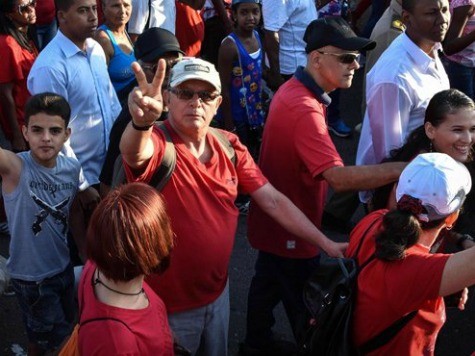The leaders of the world’s wealthiest non-jihadist terrorist organization, the Revolutionary Armed Forces of Colombia (FARC), marched openly alongside thousands forced to carry posters of Che Guevara and Fidel Castro in Havana’s Plaza of the Revolution for Marxist International Workers’ Day celebrations Sunday.
Rodrigo Londoño Echeverri, known as “Timochenko,” and Félix Muñoz Lascarro, known as “Pastor Alape,” have been exiled in Havana since 2012, after a series of CIA-backed counterterrorism operations significantly diminished the strength of the FARC. They are at the head of “peace talks” between their group and the government of Colombia hosted by communist dictator Raúl Castro, which have so far failed to result in any meaningful progress in shutting down the FARC’s terrorists and drug-smuggling operations.
On Sunday – known colloquially as May Day – the two men waved Cuban flags and wore red to celebrate the Castro regime. They were accompanied by negotiators working with the Cuban government to help legalize the FARC’s presence in Colombia.

Also accompanying the march in Cuba was socialist Venezuelan legislator Elías Jaua, there to represent the allied government of Nicolás Maduro, currently facing a recall push from an opposition that has alleged he won the 2013 presidential election through fraud.
¡ELIAS JAUA EN LA CUBA COMUNISTA DE LOS ASESINOS TERRORISTAS FIDEL Y SU HERMANO RAÚL CASTRO RUZ! ¡CUBA EN VZLA! pic.twitter.com/Rj9WTOdrAc
— Tony Planas (@cubazuelaP) May 2, 2016
Cuban national propaganda newspaper Granma is touting the May 1 celebration as one of the biggest in recent memory, with a slideshow showing people holding up signs with Fidel Castro’s face on them with messages like, “My labor helps development” and “90 Victories – for Fidel, Millions.”
One article in Granma described the rally as a “slap in the face to those who doubt Cuban socialism,” a veiled insult directed at the island’s most recent high-profile visitor, President Barack Obama. Although President Obama said he “welcomed” criticism from Castro during his visit, state media has since referred to him as a “negro” bent on “inciting rebellion and disorder,” and high-ranking officials have called his visit an “attack on our culture.”
Despite Cuba’s open embrace of the FARC terrorist group, along with various accusations that Havana has aided the Shiite terrorist group Hezbollah, President Obama removed Cuba from the State Department’s list of State Sponsors of Terrorism in April 2015.
The FARC have been in peace negotiations with the government of Colombia since 2012, negotiations regularly hampered by ceasefire violations on the part of FARC terrorists. In September 2015, President Juan Manuel Santos announced alongside Timochenko in Havana that the government had finally agreed to the terms of a peace deal, to be signed on March 23, 2016. The deal would allow most FARC terrorists to escape jail time if they hand over their weapons during an established three-month window. Santos also promised not to extradite Timochenko and other terrorist leaders at home in Havana.
On March 23, Santos announced that the working group had not yet properly ironed out the terms of a deal, so a signing would have to be postponed indefinitely. FARC leaders protested on Monday that they cannot currently sign a peace deal because the government has “exacerbated the phenomenon of paramilitarism” by beginning operations against coca farming camps and other FARC strongholds in the Colombian countryside, threatening their illicit business.
The FARC is suspected of having engaged in at least two attacks on Colombian soldiers this week, one in which a soldier died. Experts suggest that the circumstances surrounding these attacks, which violate the terms which brought the Colombian government to the table, indicate that the FARC terrorists on the ground are acting independently of leadership in Havana, possibly out of irritation that the leaders of the group are leading comfortable lives out of the line of fire while they continue to run drug-smuggling, kidnapping, and murder operations on the ground.
“The head bosses have been living in Havana for the last four years and that is not well-received by the base that continues in war,” security expert John Marulanda told Colombia’s El País.
The FARC is estimated to have killed at least 220,000 people in its 50-year history, though this estimate is considered low, as it does not take into consideration all those the FARC identified as “disappeared.”

COMMENTS
Please let us know if you're having issues with commenting.